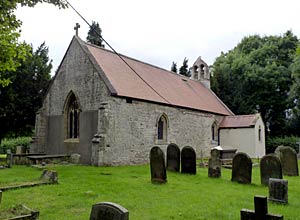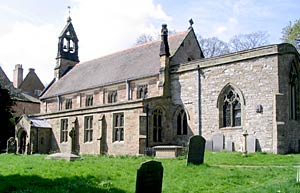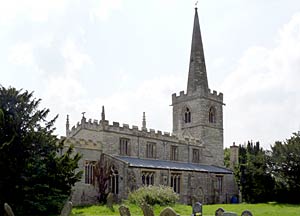< Previous | Contents | Next >

Church of St Paul, West Drayton in 2014. © Copyright Alan Murray-Rustand licensed for reuse under this Creative Commons Licence.
WEST DRAYTON. It has a handful of farms and cottages and a tiny church off the Great North Road. A footbridge from the churchyard and a field path towards the hamlet of Rockley bring us to a delightful spot where the River Maun goes racing by the white walls of the old mill house, now a charming dwelling.
We enter the simple church by the doorway of the Normans, the shafts on each side supporting an arch carved with zigzag under a scalloped hood. Near it is an old stoup. A Norman coffin stone, carved with a cross and a sword, lies outside below the west window; the fragment of another of the same time is built into the wall inside. The only old windows are the east and the west, both 15th century, with pleasing modern glass.
The Beautiful Lady

West Leake church (2006).
WEST LEAKE. A small village on a little hill, it has a stream winding from the Wolds to the Soar, and a big house of which we have a lovely peep through an arch in the garden wall. From a green sward by the roadside, sheltered by a splendid chestnut tree, the peace memorial lychgate opens on a churchyard in which a fine yew, great limes, chestnuts, and sycamores watch over a church where a lady has been sleeping since the beginning of the 14th century. She lies in a canopied recess in the chancel, wearing a wimple, one dainty hand holding the folds of her gown. She is a beautiful figure which has been said to be almost without equal among others of its time. We may believe that she was a founder or rebuilder of this place.
In a recess of the transept he may have founded lies a man of perhaps a generation after her, with curly hair, a heart in his hands, and his feet on a dog; he wears a gown patterned with crosses in circles, and may have belonged to the family whose name was that of the village. Another medieval civilian, wearing a belted gown, lies in a richly canopied recess in the aisle.
There is nothing older here than the small Norman doorway, now built-up, and some 12th and 13th century coffin stones. The chancel and the long nave arcade are 14th century, though the aisle itself is made new. Two stout oak benches are at least 400 years old.
In West Leake Woods, where he loved to roam, is a rough-hewn cross in memory of Frederick Strutt, the first Lord Belper's son. He was a naturalist and archaeologist who knew all about the countryside, and left behind a collection of local books, prints, and maps.
The Wonderful Ladder
WESTON. Church spires are rare in this part of the county, but this quiet place by the Great North Road has one of its own and looks to another three miles away, at Tuxford. The pleasing church stands facing a row of six fine chestnut trees, and has an ancient yew in its churchyard, where we found a stone with the simple epitaph, "Alas, poor Suroye." Here too is part of the shaft of the old cross, with a sundial high enough for only the tallest of us to be able to read.

Church of All Saints, Weston in 2014. © Copyright Alan Murray-Rust and licensed for reuse under this Creative Commons Licence.
Two stages of the tower are 13th century, the top storey and the spire coming from the 14th. A scowling face is among the corbels on the 14th century nave arcades; another (round which the pulpit is fitted) shows a face baring its teeth, as if at the parson. At the base of a corbel supporting the 600-year-old chancel arch is a queer little figure which seems to have the body of a snake with the bearded face of a man.
Except for old fragments, the only coloured glass in the medieval windows is of dainty formal pattern in the east. The chancel has its old sedilia, and the south aisle a piscina. A worn stoup is near the door, and a fine chest is 500 years old. We measured a stout old ladder to the belfry at 67 inches round.
There is fine old carving of tracery and elaborate arcading in the modern chancel seats and the screening of the vestry. Thirteen bench-ends of the 15th century have tracery and roses in quatrefoils; there is a Jacobean altar table, the nave roof is 1768, and fine floral bosses adorn that of the chancel. The tub font was here when Gilbert de Archis gave the church to the monks of Blyth in the 12th century.
